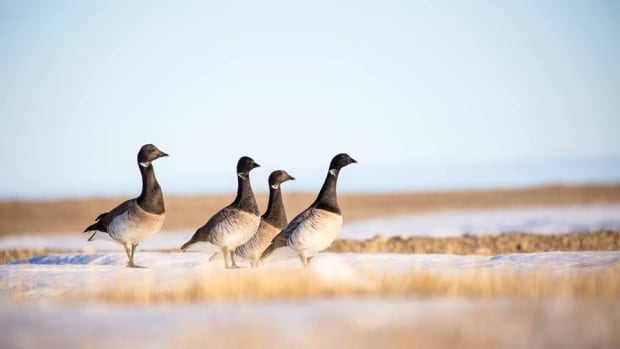It’s likely that most New Brunswickers have never heard of the Atlantic brant, a small goose that seems to have been dipped halfway into black ink. But there was a time when there were so many they would block the sun as they migrated north.
“Many locals are not old enough to remember when there were lots of brants,” said Melanie-Louise Leblanc, a researcher at the University of British Columbia who grew up in Campbellton in northern New Brunswick.
“But their parents remembered, and many have mentioned that they’ve heard stories of black clouds of brants passing through the Maritimes.”
Today, about 1,000 Atlantic brant pass through New Brunswick, and new research shows how the species depends on a small wetland on the province’s eastern coast.
According to Leblanc’s 2018 research, recently published in the Canadian Field-Naturalist Journal, Tabusintac Bay in the notheastern part of the province has been critical to the Atlantic brant’s survival.
“This is one of the very few areas where there are large numbers of brant,” said Leblanc. “They come there because of the eelgrass.”
Unlike other species, such as the Canada goose, which forages on land, the Atlantic brant relies on marine plant life, specifically eelgrass, as the main food source for the tiny geese that typically weigh around 1.2 to 1.7 kilograms.
Leblanc describes eelgrass as “underwater meadows” of yellow grass and says between the 1930s and 40s, a wasting disease caused by a slime mould all but wiped out that critical food source along the eastern seaboard. When the grass disappeared, the Atlantic brant population was devastated.
“[There was] a 90 per cent decline in the brant population when the eelgrass declined,” Leblanc said. “That’s how … dependent this bird is on this plant.”
And when the eelgrass eventually recovered, the little goose did not. In fact, the migration route of the entire species was fractured.
The Atlantic brant breeds in the Canadian Arctic and northern Greenland. Before the harsh winter months, the bird flies south to spend the season on the Atlantic coastline between Massachusetts and North Carolina.
Prior to the 1930s, the species would fly to the Maritimes, making stops along the coast to feed and rest on its way down south and on the way back to the Arctic in the spring.
When the eelgrass died off, Leblanc said, it forced most of the Atlantic brant population to fly directly overland to James Bay, north of Ontario and Quebec, where there are areas rich in eelgrass. But that’s a 1,500-kilometre journey without food.
“It’s very taxing for a bird, because resting during migration is important, having food is important, so it’s just very impressive,” said LeBlanc.

She said some researchers have tagged the birds and found some will stop at the St. Lawrence River before going to James Bay, but many make the flight without any obvious stops for food.
But between 500 and 1,000 geese still take that original pathway along the New Brunswick coast, and those birds are dependent on the underwater meadows of Tabusintac Bay.
Importance of the bay
Leblanc conducted surveys in Tabusintac Bay seven times back in 2018 using a spotting scope to conduct her counts, assisted by a drone. But she said local knowledge has been critical in assisting that research.
In fact, the community just five kilometres north of Tabusintac is called Brantville. She said hearing stories of the ‘black clouds’ of Atlantic brants from the past gave her work a sense of urgency.

According to Billie Joe Fowler, the executive director of the Tabusintac Watershed Association, the bay is a designated Ramsar site, a part of an international treaty designed to protect wetlands across the globe.
“It was agreed that there would be no hunting before one o’clock within this area,’ said Fowler. “So that would give time to all the waterfowl, geese, the ducks and the brants to feed and roost and fly away, instead of just going in there first thing in the morning with guns blazing.”

And while both Leblanc and Fowler agree that the bay is critically important to the Atlantic brant, the idea of legislating it as protected is a tricky one.
“It’s a very touchy situation because for centuries and thousands of years it seems that the community members within the area ensured that the area would be sustainable for future generations,” said Fowler. “So why should we penalize the people that use the resources every day, sustainably?”
She listed clam digging and some commercial fishing in the area as examples of the bay being used responsibly, but noted activities like the harvesting of peat moss can add sediment to the water that risks stunting eelgrass growth.
Right now, she said, the brant population using the bay has been stable and may even be rebounding a bit. As long as the area, and the eelgrass, is conserved and respected, she’s hopeful about the future of the migrating birds.


